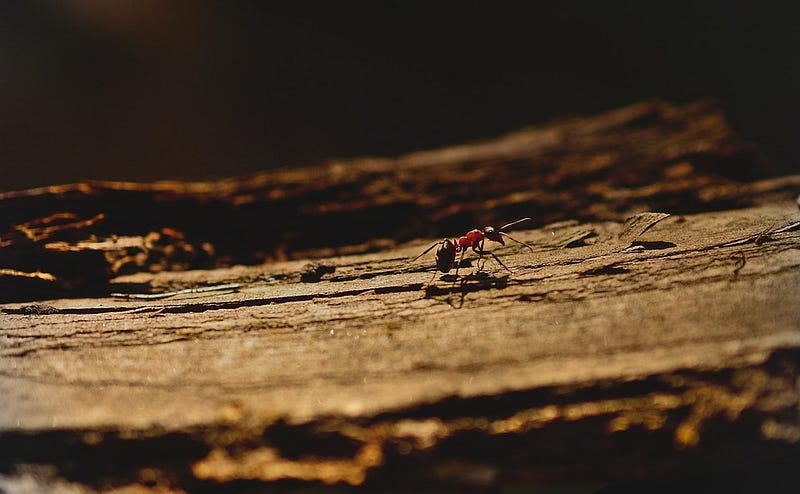Power in Numbers: Unsinkable Raft Made of Fire Ants
By Cailey Denoncourt, Bioengineering, 2022

In 2017, Hurricane Harvey flooded southeastern Texas. Accompanying the ensuing high water levels, there were alligators floating through the streets, fish in front yards, and fire ants, Solenopsis invicta, gathered on top of the water. After being displaced from their elaborate underground colonies, the thousands of fire ants had no solid ground to reconvene. In order to survive, they gathered together on top of the water, creating a rust-colored mound by biting onto each other.
These flat, round masses, scientifically called conglomerations, can become as large as 18 inches in diameter, and can remain connected for anywhere between 12 hours and 12 days, depending on the conditions. As properly named, fire ants come with a painful, stinging bite if disturbed. Thus, these “fire rafts” posed another hazard amongst the already dangerous floods.
However, this ability for the ants to self-assemble into these large, intricate rafts is quite a scientific feat. Although a singular fire ant fails to stay above water, when accompanied by thousands of other ants, they can create a weave-like structure through their cohesive strength and hydrophobic bodies.
This ability for the ants to self-assemble into these large, intricate rafts is quite a scientific feat.
In order to stay intertwined together, the fire ants grip onto each other using their mandibles (jaws), tarsal claws (feet), and adhesive pads. In other words, they use a combination of biting each other and gripping with their feet to keep the raft from falling apart. As measured in a study conducted by the Georgia Institute of Technology in 2010, the amount of force needed to separate two ants was 400 times their body weight, which is quite a feat for an ant but on a human scale is only around 2 grams. This fragile yet powerful force is just enough for the raft to float on top of water.
The majority of the raft is constructed by worker ants, with the queen ant along with some resting worker ants enjoying themselves on top. The raft is not a static structure; the worker ants are in constant motion, so the connections between the ants are constantly changing. They morph and move more like a highly-viscous fluid on top of the water.
The raft is not a static structure; the worker ants are in constant motion, so the connections between the ants are constantly changing.
Fire ants also contain a hydrophobia cuticle: a strong and flexible skin-like shell. The cuticle allows the ants to hold air against their bodies when submerged underwater; this bubble layer is known as the plastron layer. Most of the larger bubbles of air accumulate on the ventral side between the first two sets of legs and on the propodeum, or the first abdominal segment. The air pockets increase buoyancy, thus allowing the raft to stay afloat for long periods of time. However the plastron layer serves a dual purpose since it also helps the ants breathe when submerged on the underbelly of the raft.
Larvae, specifically the older third to fourth instar larvae, possess an outer bristle-like structure called setae, which helps trap more air bubbles around the worker ants. As shown by the results in a 2011 study conducted at Louisiana State University, the rafts with the larvae held up on top of the water for a longer period of time compared to those without larvae or younger larvae. As the raft grew, the size of the bubbles on the undersurface of the raft could grow to greater than one millimeter in diameter, which were surrounded underwater by submerged worker ants.
The structural aspects of the fire ants’ raft is currently being examined by researchers and roboticists for applications in man-made floatation devices.
When a stress, such as a stick, is applied to the raft, the ants are able to morph and self-heal. In unison, the ants contract their muscles in order to create a more rigid structure to adapt to the applied stress. However, this sacrifices the buoyancy of the raft due to the decrease in air pockets and higher density.
More so than just being scientifically amazing, the structural aspects of the fire ants’ raft is currently being examined by researchers and roboticists for applications in man-made floatation devices. These applications include groups of miniature robots to clean up oil spills or modeling biomaterials after interconnected ant rafts for their desirable properties of contraction, stress response, and intricate spatial arrangement. Ants are seemingly small, pesky creatures compared to the human world around them, but when ratioing out their strength and speed, they are incredibly unique.
Proceedings of the National Academy of Sciences (2011). DOI:10.1073/pnas.1016658108/
Journal of Insect Science (2011). DOI: 10.1673/031.011.17101
